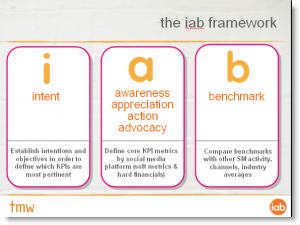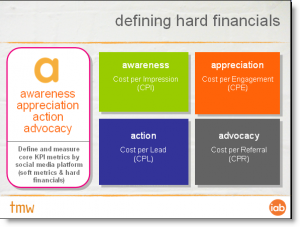One of the biggest ‘hot potatoes’ right now is how to measure social media activity and whether it’s possible to apportion ROI. It seems every man, woman and dog has an opinion on the matter!
And for good reason.
The days of whimsical experimentation have long gone. Nowadays, marketers have to justify every budget line with robust KPIs, solid business cases or definitive break-even/ ROI analysis. Not so easy when it comes to evaluating that ‘fluffy social media stuff’ but if we genuinely want this to be taken seriously it’s imperative we start making it much more accountable.
More accountability, more standardisation
But for this to happen there really needs to be a degree of standardisation across the industry so that we’re all talking the same language (or at least singing from the same ‘karaoke machine’!) But the truth is there’s currently too much inconsistency in the industry to draw any salient or meaningful conclusions. As it stands, it’s almost impossible to benchmark our respective activity as everyone is measuring performance differently. This is compounded by the fact that social media is so versatile, diverse, complex and multi-faceted, spanning many disparate objectives and many different platforms - no wonder we’ve struggled to find a common methodology which works across everything.
A step in the right direction
What I’m about to share with you may not address all these challenges but will hopefully move us in the right direction. TMW have been working in close consultation with the IAB Social Media Council to develop a new measurement framework to help practitioners evaluate their social media activity more effectively and consistently. It’s not rocket science. In fact, it’s a very simple framework, designed to be flexible enough to be applied across a broad spectrum of social media platforms, whilst at the same time giving practitioners the freedom to use their own experience and expertise to choose the most appropriate KPIs.
Rather serendipitously, the measurement framework we’re proposing shares the same acronym as the Internet Advertising Bureau, so at least it’s dead easy to remember!

You can view the full presentation of this approach below.
The presentation talks through each step of the process from establishing up front your intent, assigning the most pertinent KPIs according to the 4 As – Awareness, Apprecitation, Action and Advocacy – and consulting other benchmarks in order to draw meaningful comparisons.
There’s an array of KPIs which one can assign to each of these 4 As. As a starter for ten we’ve provided a selection to choose from but this list is not exhaustive by any means. Which KPIs you choose to apply will fundamentally vary according to the intent you define, the platform you’re using, the tracking you have in place and the internal expectations of various stakeholders and whether they demand hard financials as well as soft metrics.
Defining some hard financials
Ultimately, I believe we all need to be working towards some hard financials which over time will become established as industry standards. I’ve deliberately steered away from ROI per se – that’s a debate for another day – but instead would favour the four financial KPIs in line with the 4 As (see table below). How we calculate these KPIs is still to be defined but the principle of having one or more of this hard financials to evaluate or benchmark our activity could be extremely beneficial in my view.

Feedback welcome
The Council plans to officially promote this framework to the wider industry in a couple of weeks, but it would be great to get some feedback to ensure this is a collaborative effort. What we’ve outlined may not suit everybody but we believe it’s a step in the right direction and would encourage as many practitioners as possible to adopt it where they can. The more aligned the industry becomes, the more accountable social media will become and the easier it will be for all of us to digest the complexities of social media measurement.
Surely that’s something worth striving for?
by , senior marketing manager, Skive
It is an important part of Skive’s business to partner with agencies that we admire and who have complimentary skillsets. We regularly go into the agencies to present new work we are doing but also our observations on digital marketing. I was recently asked to give a presentation on “The Future of Digital” to the brand teams at a large PR agency.
I started off by asking how many people in the room are on twitter. About 80% said that they were and a fair proportion of them said they use it regularly, at least once a day. I then asked them how many of them were on it a year ago and the number was greatly reduced. The point is this shows how quickly technology changes and that as digital marketers we need to stay ahead of the game. The purpose of this blog post is to look at what is the future of digital and what we might expect from it in the near future.
First off we’ll start off with a quick reality check. Twitter is great right? I mean it’s everywhere, you can’t move for it. I think this is very true if you work in marketing and you spend all day plugged in to tweetdeck for the latest Social Media tidbit from Mashable or other. I’m not dumbing down its importance to those interested in the realtime web but none of my friends outside of work are on it. Let’s put it another way. Farmville has over 80 million active users that are more than the number total twitter users. When did you last suggest to a client that they try and leverage Farmville as a viable social platform?
 Read more…
Read more…
By , Skive and , TMW
Here’s some thoughts on the biggest challenge with the content user-generated space, and a couple of things we can do about them, complete with UGC checklist. Let us know what you think!
Mark runs us through the process of how brands traditionally targeted their consumers before the days of digital. He talks about how social media can drive this consumer identification method for brands in a easier more precise way through the art of conversation.
, digital social media director at Markettiers4DC, discusses how best to use broadcast within social media and how interactive video can add to your social activity. He talks about the most effective online methods when seeding content and once it’s out there, the best ways to get your consumers to interact with it. Russell also quashes the myth that all B2B brands are dull and therefore produce less interesting work, providing some great case studies along the way.
, commercial director at Unruly Media explains what viral success looks like and how you measure it. Steve also talks about the vital characteristics your video needs to make it stand out and have the ‘shareable’ factor, using ‘Charlie bit my finger’ as an example.
Watch the below videos to see the interview in full…
By , head of digital strategy, Imagination
Browsing through research and social spaces as I like to do I came across this fascinating graph on TechCrunch last week.

It’s fascinating not because it shows a drop off in Facebook from December 2009 although that’s probably worth a column in itself, but because it shows the popularity of Stumbleupon. Stumbleupon has been helping users find random, rated content since 2001. It’s not new and it’s not flashy but it is very definitely a social space.
Users love stumbleupon for 3 reasons – peer-recommendation, simplicity and serendipity. Essentially they get great stuff from people they like in their network.
I’m not suggesting that Stumbleupon should be at the heart of every social media strategy, social media strategies should not be based purely on numbers but on relevance. Still, it reminded me again about the importance of considering your audience and being sure you know where they hang out online.
What this graph clearly illustrates is that the usual suspects are just that, usual. And it can pay to truly consider the whole social market place when you are investigating social media strategies. Or you might miss the most important place to be because it’s not the most high profile.
The IAB’s resident Paxman, , interviewed , commercial director at Unruly Media about what makes a successful viral campaign to dispel the myths that surround the area. Steve talks about what results clients are looking for from their campaigns using the Evian case study as a positive benchmark for brands, and what’s makes good creative.
Watch the below video to see the full interview…
by (vice SMC chair), Head of Buzz Metrics, nielsen
When something you don’t like reminds you of something you don’t like…
You know one thing I really don’t like? Sugar cubes. They really frustrate me. I mean, for something that is supposed to be so sweet and tasty, they are so annoying. Sugar cubes take forever to dissolve, and to speed up the process, I just keep stirring and stirring, making my drink cold. In addition, their form factor is supposed to be superior, but I don’t get it. I still have to use a spoon to take one and put it in my drink, just like granulated sugar. Also, there is no way to have a half a cube of sugar in my drink like there is with the other stuff. What is this post actually about, you ask? Well, I was at a meeting this week – stirring away – when I heard yet another major company talk about how they were ‘doing social media’ as they were ‘doing Facebook and Twitter.’ When I asked them why they were using these platforms, silence filled the room and puzzled expressions came across their faces.
You see, here is how many very well known companies seem to get involved in Social Media:
- First, an executive sees a presentation at an event, reads an article, or has a meeting with a consultant who talked about the Armageddon that is social media and the end of advertising models as we know them.
- This triggers a basic corporate reaction – the message flows downhill. This executive then turns to PR, Marketing, Brand, Research, etc. and tells them to put ‘Social Media’ on their list of objectives in 2010 and to go out and ‘do social media’.
- The final stage of this process includes the selected department determining that social media is Facebook and Twitter and therefore they launch a presence on these platforms.
Thus, when I ask them why they are doing this – i.e. what are their goals or objectives in using these platforms – they draw a blank. Social Media is a huge topic with so many activities, platforms, technologies, and aspects that it can overwhelm the most sophisticated and experienced business leader. The topic is so broad and vast, that trying to label or define it can become comical (just ask the IAB UK Social Media Council).
Rather than measure ‘social media,’ I believe companies should place much more emphasis on listening and using social media for strategy creation rather than jump right into execution or engagement. Listening and learning from this then can inform decisions to focus on destinations like Facebook and Twitter. Alternatively, companies and brands should look to define their objectives first, then determine if social media is a viable way to meet these objectives. For example, a brand may want to increase awareness, advocacy, retention, or churn, or decrease negative discussion and identify threats. A brand may want to begin to measure and treat each mention like an impression, something they are more familiar with measuring. Each of these components is much easier to breakdown into its individual parts and measure accurately and effectively. Otherwise, in my mind, social media measurement becomes as useful as a sugar cube.
At our first session for our Rising Voice in social media programme from RMM took the delegates through the 6 types of social media. Matt used a colourful party planner analogy with case studies and tips to do this.
Watch the below to see the full presentation…





